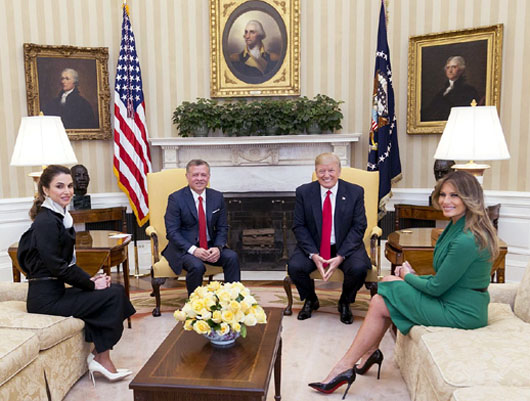by WorldTribune Staff, March 13, 2019
A flurry developments on the Middle East peace front are preceding the Trump administration’s expected unveiling next month of its peace plan for the region.
On March 11, the Trump administration’s Middle East peace team met in Washington with Jordan’s King Abdullah II.

On March 12, Prime Minister Benjamin Netanyahu revealed that Israel “is currently in contact with half a dozen important Arab and Islamic countries, which up until recently were hostile to Israel.”
U.S. special representative for international negotiations Jason Greenblatt and White House senior adviser Jared Kushner have been working on plan, which is expected to be made public soon after the April 9 election in Israel.
In an interview with Sky News in Arabic, Kushner said the plan “is very detailed and will focus on delineating the border and providing solutions to the main issues that are controversial and will be appropriate for the current situation on the ground.”
Kushner and Greenblatt recently met with several leaders of Arab states and discussed the peace plan.
Kushner, Greenblatt and Secretary of State Mike Pompeo attended the March 11 meeting with King Abdullah which took place at the Jordanian ambassador’s residence.
“Pompeo reaffirmed the strength of the U.S.-Jordan bilateral relationship and discussed several matters of mutual interest, including Jordan’s commitment to economic reform and developments in the region related to the conflict in Syria,” the State Department said.
Palestinian Authority leader Mahmoud Abbas has rejected the U.S. peace plan before it has even been unveiled.
Netanyahu has shown more openness toward the plan. During a summit in Warsaw last month, Netanyahu said, “I don’t think that any of us should reject the plan and reject this initiative by the American administration before it’s even presented.”
During a state memorial ceremony for former Prime Minister Levi Eshkol on March 12, Netanyahu said Israel is also “continuing to take vigorous action against Iran’s attempts to entrench militarily in Syria. We are also doing so in the face of the aggression of Hizbullah and Hamas, whose tunnels we are systematically dismantling.”
“Only when our neighbors are convinced that our strength and our presence here are irrefutable facts, only then some of them will be persuaded to make peace with us, and we are fully advancing this recognition and agreement process with our remaining neighbors, not with all of them, but with most of them,” said Netanyahu.
Towards the end of his remarks, Netanyahu added, “We are doing this with extensive segments of the Arab and Islamic world in an expedited normalization process, only part of which the public can see. We are also holding this process in secret, and Israel is currently in contact with half a dozen important Arab and Islamic countries, which up until recently were hostile to Israel.”
Meanwhile, the Syrian government on March 12 condemned a statement by U.S. Sen. Lindsey Graham, South Carolina Republican, who said that the Golan Heights should remain “forever” under the control of Israel.
Graham, who toured the Golan Heights with Netanyahu on March 11, said the idea of the strategic plateau going to any party other than Israel was “off the table,” vowing to work to have the United States recognize the Golan as part of Israel “now and forever.”
A Syrian foreign ministry source told the state-run SANA news agency that Graham’s remarks demonstrated “the arrogance of the U.S. administration and how it views regional issues with Zionist eyes and with the interests of Israel” in mind.
“The Syrian people… are more resolute and determined to continue their struggle until the occupied Golan is fully liberated,” added the Syrian source.
Israel captured most of the Golan Heights from Syria during the June 1967 Six Day War. While Israel ceded a portion of the Golan Heights as part of a separation of forces agreement with Syria following the 1973 Yom Kippur War, the Jewish state has retained roughly two-thirds of the Heights.
In 1981, the Menachem Begin government applied Israeli sovereignty over the Golan – a move not internationally recognized, including by the U.S.
Netanyahu recently asked the United States to recognize Israel’s sovereignty over the Golan Heights. Netanyahu’s request came during a meeting with U.S. national security adviser John Bolton.
U.S. ambassador to Israel David Friedman told the Israel Hayom newspaper in September of 2018 that he expected the Golan Heights to remain under Israeli control “forever,” and mentioned the possibility of U.S. official recognition of the Golan as Israeli territory.
Bolton had said in August 2018 that there were no U.S. plans for such recognition.
In November, the United States voted for the first time against an annual UN resolution condemning Israel’s “occupation” of the Golan.
Check Out Geostrategy-Direct __________ Jump Start the U.S. Media
